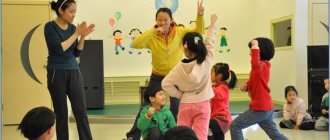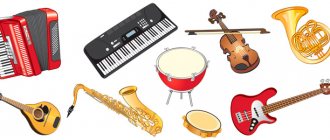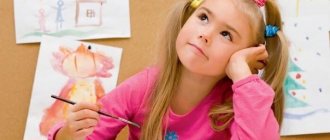Theatrical activities in preschool age
Tatiana Gryaznova
Theatrical activities in preschool age
Report
THEATER ACTIVITIES FOR CHILDREN IN KINDERGARTEN
Teacher: Gryaznova Tatyana Sergeevna Dzerzhinsk 2019
INTRODUCTION
1. THE IMPORTANCE OF THEATER EDUCATION FOR PRESCHOOL
2. GAME AS ONE OF THEATERIC ACTIVITIES
CONCLUSION
BIBLIOGRAPHY
APPLICATIONS
INTRODUCTION
Modern preschool institutions are painfully searching for new humanistic, personality-oriented approaches to education. Today, many teachers are concerned about finding unconventional ways to interact creatively with children.
How to make every activity with a child interesting and exciting, to simply and unobtrusively tell him about the most important thing - about the beauty and diversity of this world, how interesting it is to live in it? How to teach a child everything that is useful to him in this complex modern life? How to educate and develop his basic abilities: to hear, see, feel, understand, fantasize and invent?
The most popular and exciting area in preschool education is theatrical activities . From the point of view of pedagogical attractiveness, we can talk about the versatility, playful nature and social orientation, as well as the correctional capabilities of the theater .
It is theatrical activities that make it possible to solve many pedagogical problems related to the formation of the expressiveness of a child’s speech, intellectual and artistic-aesthetic education. By participating in theatrical games , children become participants in various events from the lives of people, animals, and plants, which gives them the opportunity to better understand the world around them. At the same time, theatrical play instills in the child a sustainable interest in his native culture, literature, and theater .
of theatrical games is also enormous . Children develop a respectful attitude towards each other. They learn the joy associated with overcoming communication difficulties and self-doubt. Children’s enthusiasm for theatrical play , their inner comfort, relaxedness, easy, non-authoritarian communication between an adult and a child, the “I can’t do it”
- all this surprises and attracts.
It is obvious that theatrical activities teach children to be creative individuals, capable of perceiving novelty and the ability to improvise. Our society needs a person of such quality who could boldly enter into a modern situation, be able to handle a problem creatively, without prior preparation, and have the courage to try and make mistakes until the right solution is found.
1. THE IMPORTANCE OF THEATER EDUCATION FOR PRESCHOOL
Theatrical games are of great importance in a child’s life. They fully develop the child’s speech. The process of speech development involves mastering not only the content, but also the figurative, emotional side of the language. To develop the expressive side of speech, it is necessary to create conditions in which each child could express his emotions, feelings, desires, views, not only in ordinary conversation, but also publicly, without being embarrassed by the presence of outside listeners. It is important to teach this in early childhood, since it often happens that people with rich spiritual content and expressive speech turn out to be withdrawn, shy, and get lost in the presence of unfamiliar faces.
The habit of expressive public speech can be cultivated in a person only by involving him in speaking in front of an audience from an early age. Theater in kindergarten can be of great help with this . Theatrical games always delight children and are always loved by them. By participating in plays and performances, children get acquainted with the world around them in all its diversity through images, colors, sounds, and skillfully posed questions force them to think, analyze, draw conclusions and generalizations. Improvement of speech is also closely related to mental development. In the process of working on the expressiveness of characters’ remarks and their own statements, the child’s vocabulary is imperceptibly activated, the sound culture of his speech and its intonation structure are improved. The role played and the spoken lines confront the child with the need to express himself clearly, distinctly, and intelligibly. His dialogical speech and its grammatical structure improve.
It can be argued that theatrical activity is a source of development of feelings, deep experiences and discoveries of a child, and introduces him to spiritual values. This is a concrete, visible result. But it is no less important that theatrical activities develop the emotional sphere of the child, make him sympathize with the characters and empathize with the events being played out.
Thanks to the works, the child understands the world not only with his mind, but also with his heart, and expresses his own attitude towards good and evil. Favorite heroes become role models and identification. This is why teachers can have a positive impact on children through children's performance.
Such games help overcome timidity, self-doubt, and shyness. It is obligatory to look at illustrations in children's books or just pictures that match the work you read. Then children learn to convey the mood and character of the characters through facial expressions and movements during physical education and music classes.
After a conversation about what has been read and similar exercises, it is necessary to return to the text again, involving the children in pronouncing its individual fragments. Moreover, you should never demand a literal reproduction of the content. If necessary, you can easily correct the child and move on without delay. However, when the text is well understood, accuracy and expressiveness of its presentation should be encouraged. At first, fragments from the works are used as an exercise, gradually the tasks become more complicated. The teacher faces two main tasks: firstly, to understand, figure out what the baby feels, what his experiences are aimed at, how deep and serious they are, and, secondly, secondly, to help him express his feelings more fully, to create for him special conditions in which his activity will manifest itself, his assistance to those about whom he has heard. After such preparation, the entire work is played out in its entirety. You can’t divide children into “artists”
and
“spectators”
, i.e. constantly performing and constantly staying to watch
“play”
.
Parents should take an active part in preparing children for theatrical activities : helping the teacher in making various theaters , costumes, selecting the necessary literature, organizing performances for children (for young children, parents are artists, for older children, parents are often spectators).
When teaching children the means of verbal expression, it is necessary to use familiar and favorite works. theatrical activities help them adapt better and faster in kindergarten and develop them comprehensively. Almost all children speak well, but each has its own character, not all of them are sociable, each reacts in its own way to strangers, does not want to communicate with them. Theatrical activity develops their speech , gives each child the opportunity to get comfortable, and makes kindergarten for them a place where they want to come. When working with children, we use small sketches, act them out, and include finger exercises and sound pronunciation exercises in our classes. These classes reinforce children's sensory knowledge, design skills, fine arts, and movement development. Children really like this.
GAME AS ONE OF THEATERIC ACTIVITIES
Theatrical games are the acting out of literary works (fairy tales, short stories, specially written dramatizations)
.
The heroes of literary works become characters, and their adventures, life events, changed by children's imagination, become the plot of the game. The peculiarity of theatrical games is that they have a ready-made plot, which means activity is largely predetermined by the text of the work.
Real creative play is a rich field for children's creativity. After all, the text of a work is like a canvas into which children themselves weave new storylines, introduce additional roles, change the ending, etc. In a theatrical play, the image of the hero , his main features, actions, and experiences are determined by the content of the work. The child's creativity is manifested in the truthful portrayal of the character. To do this, you need to understand what the character is like, why he acts this way, imagine his state, feelings, that is, penetrate into his inner world. And this needs to be done while listening to the work.
All this suggests that children’s full participation in play requires special preparedness, which is manifested in the ability to aesthetically perceive the art of literary expression, the ability to listen attentively to the text, to capture intonations, and peculiarities of speech patterns. To understand what a hero is, you need to learn how to simply analyze his actions, evaluate them, and understand the moral of the work. The ability to imagine the hero of a work, his experiences, the specific environment in which events develop, largely depends on the child’s personal experience: the more diverse his impressions of the life around him, the richer his imagination, feelings, and ability to think. To play the role, the child must master a variety of visual means (facial expressions, body movements, gestures, speech expressive in vocabulary and intonation, etc.). Consequently, preparedness for a theatrical play can be defined as a level of general cultural development on the basis of which the understanding of a work of art is facilitated, an emotional response to it arises, and mastery of artistic means of conveying an image occurs. All these indicators do not develop spontaneously, but are formed in the course of educational work.
Theatrical themselves are part of such educational work. It is of great importance for the development of the personality of a preschool child, not only because it exercises individual mental processes, but also because these processes rise to a higher level of development due to the fact that the child’s entire personality, his consciousness, develops in the game. The child becomes aware of himself, learns to desire and subordinate his fleeting affective aspirations to desire; learns to act, subordinating his actions to a certain pattern, rule of behavior, learns to live, living the lives of his heroes, loving or not loving and trying to understand the essence and reasons for their actions and learning from their mistakes.
There are many varieties of theatrical games , differing in artistic design, and most importantly, in the specifics of children's theatrical activities . In some, children present the performance themselves, like artists; Each child plays his role. In others, children act as if in a director's game: they act out a literary work, the characters of which are portrayed with the help of toys, voicing their roles. Similar are performances using a tabletop theater with three-dimensional and flat figures or the so-called bench theatrical games , in which children play on a flannelgraph, screen using pictures (often cut out along the contour)
show a fairy tale, story, etc. The most common type of bench
theatrical games is shadow theater .
Sometimes children act as real puppeteers; in such a game, two types of theatrical toys . The first is the parsley type - the parsley theater (in practice it is often called the bibabo theater , where glove-type puppets are used: a doll, hollow inside, is put on the hand, while the index finger is placed in the head of the doll, the thumb and middle finger are placed in the sleeves of the suit, the remaining fingers are pressed to the palm. The performance is shown from behind a screen: the puppeteers hold the puppets above their heads.
In theatrical games, various types of children's creativity are developed: artistic and speech, musical and playful, dancing, stage, singing. With an experienced teacher, children strive for an artistic depiction of a literary work not only as “artists” performing roles, but also as “artists” designing the performance, as “musicians” providing sound accompaniment. Each type of such activity helps to reveal the individual characteristics and abilities of the child, develop talent, and captivate children.
Of particular note is the role of theatrical games in introducing children to the arts: literary, dramatic, theatrical . Preschoolers get acquainted with various types of theatrical art . With proper guidance, children develop ideas about the work of artists, directors, theater designers , and conductors. Children of senior preschool age understand that the performance is prepared by a creative team (everyone does one thing together - the performance)
.
By analogy with the experience of their own theatrical games, children feel and realize that theater gives joy to both creators and spectators.
Dramatization or theatrical play poses many very important tasks for the child. Children should be able, with a little help from the teacher, to organize into play groups, agree on what will be played out, determine and carry out the basic preparatory actions (select the necessary attributes, costumes, decorations, design the scene, select the role players and the presenter, perform several times trial play); be able to invite the audience and show them the performance. The speech and pantomimic actions of the role players must be quite expressive (intelligible, intonationally diverse, emotionally charged, purposeful, figuratively truthful).
Thus, in the process of organizing a theatrical game, children develop organizational skills and abilities, improve forms, types and means of communication, develop and understand the direct relationships of children with each other, and acquire communicative skills. In preschool age, for the first time, the need to be treated well by people around you, the desire to be understood and accepted by them, appears. Children in the game look closely at each other, evaluate each other and, depending on such evaluations, show or do not show mutual sympathy. The personality traits they discover in the game determine the relationships that form. Peers refuse to deal with children who do not follow the established rules in the game and demonstrate negative character traits in communication. Personality emerges in communication, built on a conscious, motivated basis. In the process of play and preparation for it, relations of cooperation, mutual assistance, division and cooperation of labor, care and attention to each other develop between children. In games of this kind, children learn to perceive and transmit information, focus on the reactions of their interlocutors and spectators, and take them into account in their own actions. This is especially important in order to be able to quickly navigate and control oneself in a difficult situation that may arise during a performance, for example: one of the participants forgot their words, mixed up the order, etc. Therefore, mutual understanding between the participating children is very important and mutual assistance, which develop during the game and preparation for it.
Theatrical activities add variety to the life of a child in kindergarten, give him joy and are one of the most effective ways of corrective influence on a child, in which the principle of learning is most clearly manifested: learning by playing.
During theatrical games :
children’s knowledge about the world around them expands and deepens;
mental processes develop: attention, memory, perception, imagination;
mental operations are stimulated;
development of various analyzers occurs: visual, auditory, speech motor;
vocabulary, grammatical structure of speech, sound pronunciation, coherent speech skills, melodic-intonation side of speech, tempo, expressiveness of speech are activated and improved;
motor skills, coordination, smoothness, switchability, and purposefulness of movements are improved;
the emotional-volitional sphere develops;
behavior correction occurs;
a sense of collectivism and responsibility for each other develops, and the experience of moral behavior is formed;
the development of creative, search activity, and independence is stimulated;
participation in theatrical games brings joy to children, arouses active interest, and captivates them.
Rules for preparing for the performance:
do not overload children;
do not impose your opinion;
provide all children with the opportunity to try themselves in different roles.
Stages of working on a performance
Choosing a play or dramatization, reading, discussion.
Dividing into episodes and retelling them by children.
Work on episodes in the form of sketches with improvised text.
Searching for musical and plastic solutions for individual sketches, staging dances and songs, creating sketches of scenery and costumes with children and parents.
Transition to the text of the play: work on episodes (expressiveness of speech, authenticity of behavior in stage conditions)
.
Rehearsal of individual paintings in different compositions with details of scenery and props (possibly conventional, with musical accompaniment.
Rehearsal of the entire play with costumes, props, scenery. Clarifying the tempo of the performance.
Premiere of the play. Discussion with children and spectators.
Rerun of the performance. Preparing an exhibition of children’s drawings based on the performance, as well as a stand or album with photographs.
Among creative games, children are especially fond of “ theater” , dramatizations, the plots of which are well-known fairy tales, stories, and theatrical performances .
By participating in theatrical games , children get acquainted with the world around them through images, colors, and sounds. Theatrical and play activities enrich children with new impressions, knowledge, skills, develop interest in literature, activate the vocabulary, and contribute to the moral and ethical education of each child.
Participation in theatrical games , the child enters the image, transforms into it, lives its life. Therefore, along with verbal creativity, dramatization or theatrical production represents the most frequent and widespread type of children's creativity.
Game-dramatization allows you to solve many problems of the kindergarten program: from familiarization with social phenomena, the formation of elementary mathematical knowledge of physical perfection.
The variety of themes, means of representation, and emotionality of games make it possible to use them for the purpose of comprehensive personal development.
The figurative, vivid depiction of social reality and natural phenomena characteristic of the dramatization game introduces children to the world around them in all its diversity. And skillfully posed questions in preparation for the game encourage them to think, analyze rather complex situations, draw conclusions and generalizations. This contributes to the improvement of mental development and the closely related improvement of speech. In the process of working on the expressiveness of characters’ remarks and their own statements, the child’s vocabulary is imperceptibly activated, and the sound side of speech is improved. A new role, especially the dialogue of characters, confronts the child with the need to express himself clearly, distinctly, and intelligibly. His dialogical speech and its grammatical structure improve, he begins to actively use the dictionary, which, in turn, is also replenished.
CONCLUSION
Thus, theatrical activities comprehensively develop the child. They make it possible to frequently and unobtrusively give children knowledge on sensory skills, mathematics, introduce them to the world around them, improve movements, finger motor skills, and acquire skills in artistic activities . Preparation for theatrical activities should take place in several stages. First, the teacher needs to read the work expressively, and then conduct a conversation on it, explaining and clarifying the understanding of not only the content, but also individual means of expression. One of the main conditions is the emotional attitude of an adult to what is being read. When reading, children need not so much artistry as the sincerity and genuineness of the teacher’s feelings. For kids, this is like a model of an emotional attitude to certain situations. Moreover, the smaller the child, the more specific and accentuated the reading should be.
The role of the teacher in organizing and conducting such games is very great. It consists in setting fairly clear tasks for the children and quietly transferring the initiative to the children, skillfully organizing their joint activities and directing them in the right direction; do not leave without attention a single issue, both organizational and issues relating to each child personally (his emotions, experiences, reactions to what is happening)
; to the difficulties children face. It is very important for the teacher to take an individual approach to each child.
Thus, play should be a school of activity in which the subordination of necessity appears not as imposed from the outside, but as responding to the child’s own initiative, as desired. Theatrical play in its psychological structure is a prototype of future serious activity - life .
BIBLIOGRAPHY
Artemova L. V. Theatrical games for preschoolers (methodological manual, M, 2006.
Borovik T. A., Zhilin V. A., Tyutyunnikova T. E. Using elements of orf pedagogy of innovative teachers in the production of theatrical games , St. Petersburg, - 1999.
Petrova T. I., Sergeeva E. L., Petrova E. S. Theatrical games in kindergarten (methodological manual, Nizhny Novgorod, - 2008.
Technology of problem-based developmental education in the practice of using theatrical performances in preschool institutions (methodological manual, St. Petersburg, VLADOS, 2005.
APPLICATIONS
“Whose voice is this?”
( Theatrical mini-game for children of primary preschool age )
Purpose of the game: To distinguish between adult animals and young animals by onomatopoeia, to correlate the names of an adult animal and its young.
For this game you will need masks or mini-costumes (distinctive features: tails, paws, ears and whiskers)
: mouse and little mouse, duck and duckling, frog and little frog, cow and calf, cat and kitten.
If choosing masks or costumes causes difficulties, you can select pictures or fashion toys from plasticine, involving the child in joint activities .
They come to visit the child (they come by car, by train)
animals, they want to play. The child must guess whose voice he heard.
Meow meow. Who is that meowing? (Cat.)
And who meows in a thin voice?
(Kitten.)
The mother cat has a baby.
How does he meow? (Meow-meow.)
Moo-oo - who moos like that? (Cow.)
And who is her cub?
(Calf.)
What voice does he moo in?
(Thin.)
Now listen again and guess who is mooing - a cow or a calf.
Kwa-kwa - whose rude voice is this? (Frogs.)
And who croaks thinly?
(Little frog.)
The frog is large and croaks in a rough voice, and its baby croaks thinly. Who is the baby frog?
In such theatrical mini-games, children learn to distinguish between adult animals and their young by onomatopoeia (a cow moos in a loud voice, and a calf in a quiet, thin voice; a frog croaks loudly, and a little frog croaks subtly).
Its emotionality and expressiveness depend on the sound design of a statement, so it is important to teach children the ability to clearly pronounce simple phrases using the intonation of a whole sentence, question or answer.
"Wind"
( Theatrical game for children of primary preschool age )
The purpose of the dramatization : To teach children to form verbs using prefixes (looked out, rushed, jumped)
.
Organization of activities .
One of the children plays the role of the breeze, the rest - hares. Children-hares put hats with long ears on their heads and squat down in a circle. To the words spoken by the teacher:
From a snowdrift at the edge of the forest
Someone's ears peeked out,
And he rushed - hop and hop -
White little ball
Children slowly rise and jump forward on two legs.
Artemyeva I. V.
methodologist MBOU DPO (PC) Central Educational Institution of the city. Samara
Preschool age is a bright, unique page in the life of every person. During this period, the process of socialization of the child begins, familiarization with culture, universal norms and values occurs, and the foundation of health is laid. Preschool childhood is also an important stage in raising an attentive, sensitive reader who loves books.
Today the whole world is faced with the problem of maintaining interest in books, in reading as a process and leading human activity. Modern children are increasingly spending their free time playing computer games, watching TV shows, especially cartoons, and reading books less and less. But fiction plays a big role in the personal development of every person. We, adults, need to understand: reading for a preschooler is the most natural and calm, psychologically comfortable way to learn about the world and people. A book should enter a child’s world as early as possible, enrich his world, make it interesting, full of unusual discoveries.
Reading fiction is one of the forms of joint partnership between an adult and children. This activity cannot be continued by preschoolers independently or become their free activity, since they do not know how to read fluently and depend on an adult.
In order to raise a reader in a child, the adult himself must show interest in the book, understand its role in a person’s life, know the range of children’s reading, follow the latest in children’s literature, be able to have an interesting conversation with the child about what he read, and be sincere in expressing his feelings.
Theatrical activities have special potential for introducing preschoolers to reading fiction. It will help to form the correct model of behavior in the modern world, improve the child’s general culture, introduce him to children’s literature, music, fine arts, etiquette rules, rituals, and traditions.
Theatrical activity is a child’s creative activity associated with the modeling of images, relationships, and the use of various expressive means: facial expressions, gestures, pantomimes. Theatrical games are an interesting, understandable and accessible activity for children. Therefore, even the most timid, insecure children usually take part in them.
Theatrical games in preschool age involve acting out literary works (fairy tales, short stories, specially written dramatizations). The heroes of literary works become characters, and their adventures and life events become the plot of the game.
The first theatrical games are conducted by the teacher himself, involving the children in them. Further, the classes use small exercises and games in which the teacher becomes a partner in the game and invites the child to take the initiative in organizing it, and only in older groups can the teacher sometimes be a participant in the game and encourage children to be independent in choosing a plot and playing it out.
Based on the works of Antipina E. A. and Churilova E. G., several stages can be distinguished in introducing preschool children to theatrical activities.
The first stage of work is related to the selection of a work of fiction. Next, the teacher reads the work to the children and conducts a conversation on its content, paying attention to small details.
The second stage includes: dividing the play into episodes, discussing candidates for the roles of characters in the work, and retelling them by role.
At the third stage, work is carried out on individual episodes in the form of sketches with improvised text. First, the most active children become participants in the etudes, then everyone else is involved. You can improvise the actions and dialogues of the characters with dolls.
At the fourth stage, children are introduced to musical works that will be played in whole or in fragments during the theatrical performance. Vivid musical images help children find the appropriate plastic solution. At first, children simply improvise movements to the music. Then they move, turning into some character, changing their gait, postures, gestures, watching each other.
The fifth stage involves a gradual transition to the text of the work. During rehearsals, the same passage is repeated by different performers, which allows children to quickly learn almost all the roles. At this stage, the proposed circumstances of each episode are clarified (where, when, at what time, why, why) and the motives for the behavior of each character are emphasized (for what? for what purpose?). Children, watching the actions of different performers in the same role, are able to evaluate who does it more naturally and truthfully.
The sixth stage is related to working on the role. Due to age characteristics, a child always plays himself; he is not yet able to transform, play the feelings of another person. Under no circumstances should you impose on preschoolers the logic of another person’s actions or your own specific patterns of behavior. It’s better to give a hint and help the child remember some life episode when he had to experience feelings similar to those of the characters in the work. Only in this case will the children’s behavior on stage be natural and genuine. It is very important to achieve interaction with partners, the ability to hear and listen to each other and, accordingly, change your behavior. When working on the expressiveness and clarity of speech, it is necessary to identify the speech characteristics of the characters in the work. Different casts of performers can offer their own options; it is advisable to consolidate some of the most successful mise-en-scène for further work on the performance.
At the seventh stage, a rehearsal of individual paintings in different compositions is carried out. We must ensure that children do not repeat the poses, gestures, and intonations of other performers, but look for their own variations. It is necessary to teach children to place themselves on stage without crowding together or blocking each other. Any discovery, a new successful solution must be encouraged, this is successfully done by the audience, children who are not currently busy in rehearsal.
The eighth stage is the shortest in time. Rehearsals of the entire play. The scenery, props and props prepared for the performance are used, as well as costume elements that help in creating the image. The rehearsal is accompanied by musical accompaniment, and the tempo of the performance is specified. At this stage, children's responsibilities in preparing props and changing scenery are assigned. The number of general rehearsals for the entire performance can be from one to three.
The ninth stage - the premiere of the performance - is also a dress rehearsal, since until this moment the children have never acted in costumes. The next day after the performance, a conversation is held. The teacher, together with the children, tries to point out the main mistakes and shortcomings in the performance. But, at the same time, the teacher tries to praise the children and note the most successful and interesting moments of the performance.
The final stage is reruns of the performance. It is advisable to record the work on the production and each performance (stands with photographs, exhibitions of children's drawings, video recordings). It is very interesting to compare video recordings of several performances.
Performances can be performed in different casts. The same role, when performed by different children, completely changes, acquiring new colors and sound. The teacher’s task is to reveal the child’s individuality, teach him to look for his own means of expression, and not to imitate other performers (E. G. Churilova).
Based on the foregoing, we can conclude that theatrical play is closely related to literary and artistic creativity. Constant communication with a book actively develops reader interest, as well as creative abilities and inclinations, which are successfully realized under the guidance and help of a teacher in role-playing games, based on the plots of literary works, in dramatizations and dramatizations, and expressive reading of poetry.
We must understand that by caring about nurturing reader interest, we care about the intellectual, moral, spiritual potential of our country, about its cultural and creative development, economic and political well-being, and national security.
Bibliography
1. Akulova, O. Theatrical games // Preschool education, 2005. – No. 4. – P. 24 – 26.
2. Antipina, E. A. Theatrical activities in kindergarten. – Moscow, 2003.
3. Balakireva, T. Emotions and children // Preschool education, 2005. – No. 1. – P. 65 – 68.
4. Gorshkova, E. V. About “talking” movements and miraculous transformations. – Moscow: Bustard, 2007. – 79 p.
5. Zimbardo, F. Shy child. – Moscow: ACT Astrel, 2005. – 294 p.
6. Klimenkova, O. Game as the ABC of communication // Preschool education, 2002. – No. 4. – P. 7 – 19.
7. Makhaneva, M. D. Theatrical classes in kindergarten: A manual for preschool workers. institutions. – Moscow: Sphere shopping center, 2001. – 128 p.
8. Migunova, E. V. Organization of theatrical activities in kindergarten: Educational method. allowance. – Veliky Novgorod: NovSU named after. Yaroslav the Wise, 2006.
9. Petrova, E. Theatrical games // Preschool education, 2001. – No. 4. – P. 32 – 39.
10. Sorokina, N. F. Playing puppet theater: Program “Theatre-creativity-children”. – Moscow: ARKTI, 2004.
11. Chistyakova, M. I. Psychogymnastics / Ed. M. I. Buyanova. – 2nd ed. – Moscow: Education: VLADOS, 1995. – 160 p.
12. Churilova, E. G. Methods and organization of theatrical activities for preschoolers and junior schoolchildren. – Moscow: Vlados, 2001.
1. These ideas served as the impetus for the use of theatrical games to develop children’s speech. In my teaching activities, I strive to ensure that children feel comfortable in any environment, in any speech situation. So that they can easily enter into dialogue, can argue their point of view with dignity and respect for others, and be attentive listeners and friendly interlocutors. Theatrical games always delight children and are very popular among them. Children see the world around them through images, colors, and sounds. The guys laugh when the characters in the play laugh, they feel sad and upset with them, they can cry over the failures of their favorite fairy-tale hero, and they are always ready to come to his aid. In the process of theatrical activities with children, I try to pay attention to developing interest in the creativity of improvisation in the process of inventing the content of the game and embodying the intended image using various means of expression. I bring children to the idea that the same character, the same situation, can be shown in different ways. In theatrical games, I encourage the desire to come up with your own ways of realizing your plans, to act depending on your understanding of the content of the text. Thus, in fiction classes, children enjoy participating in the dramatization of such fairy tales as “Kolobok”, “Teremok”, “Turnip” and others. They act out fairy tales with theatrical dolls. This allows them to better understand the content of their favorite work and gives them the opportunity to show creativity. I also suggest composing short fairy tales and songs. Most children complete the task quite easily. I gradually introduce noise instruments (tambourine, drum, rattles, bells), which give the song composed by the child a new sound, create a festive atmosphere, and develop a sense of rhythm. During the lesson, I include theatrical play as a play technique and a form of teaching children. The playful form of the lesson helps to emancipate the child and create an atmosphere of freedom. Thus, in literacy classes, with the help of theatrical games, I teach children the correct pronunciation of sounds. So, I can say with confidence that the use of theatrical games in the classroom increases the effectiveness of the pedagogical process. They also contribute to the development of speech, memory, thinking, and have a huge impact on the mental development of the child. Conducting classes with elements of theater pedagogy helps each child demonstrate their skills, creative tendencies, and learn the material faster and better.
2. Theatrical games are an interesting, understandable and accessible activity for children. Therefore, even the most timid, insecure children began to take part in them.
3. Analyzing my work, I can say that theatrical and play activities enriched children with new impressions, knowledge, developed an interest in literature, and also activated their vocabulary, improved coherent speech, the sound side of speech and its expressiveness. And most importantly, thanks to theatrical games, children became more liberated.






